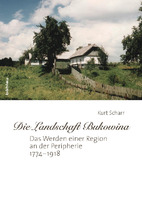Die Landschaft Bukowina
Das Werden einer Region an der Peripherie 1774–1918
Author(s)
Scharr, Kurt
Collection
Austrian Science Fund (FWF)Language
GermanAbstract
Bucovina was an integral part of Habsburg Empire since 1775. Starting from a pure political construction on the European map of power at the end of 18th century this small area developed into a well integrated Austrian crown land. A crown land, which succeeded to form a certain regional identity – conform to the Habsburg state ideology. Till the outbreak of First World War national rivalries played a certain role for regional politics in the county but were moderate in general. Especially this situation was grounded in a direct liaison of this small province situated on the Eastern slopes of Carpathians with Vienna as imperial centre. A development which aimed towards steadily improving inner consolidation and balance in comparison with the other crown lands of the Empire. Only the outcome of the First World War, as Bucovina became part of the Romanian kingdom, loosing its geo strategic position as a bridge between East and West, showed in its consequences the former importance of this organic exchange with Vienna, shaping the provinces society and cultural landscape.
The genesis of Bucovina region at the periphery of a European Empire from the end of 18th up to the beginning of 20th century as well as the structural persistence of the cultural landscape’s characteristics is centrally focussed in this study. The analyses of spatial processes as well as their genesis, shaped by a changing geopolitical situation, were of main interest for the research. Since the midst of 19th century a serious and existential national tension within the Bucovina was growing which could only partially be influenced by the province politics itself. A tension in between a search for a distinguished political position, the new idea of nation state and a overall-covering ideology of Commonness, a tension between growing regional identity, of beeing Bucovina and increasing national claims. The study tries to draw a knew, integral and less known picture of this variously shaped cultural landscape – apart from common nationalistic and segmented analyses. Die Bukowina, seit 1775 zu den Ländern der Habsburgermonarchie gehörend, entwickelte sich ausgehend von einem politischen Konstrukt auf der Landkarte Europas im letzten Drittel des 18. Jh. hin zu einem durchaus selbstbewussten Kronland, dem es bis 1914 gelungen war, eine (staatskonforme) regionale Identität aufzubauen. Bis zum Ausbruch des Ersten Weltkrieges spielten nationale Rivalitäten eine gewisse Rolle, waren in ihren Forderungen jedoch als moderat einzuschätzen. Besonders die direkte Abhängigkeit dieses kleinen Landstrichs am Ostabhang der Karpaten von Wien als Reichshauptstadt legte den wesentlichen Baustein zu dieser Entwicklung. Eine Entwicklung, die v. a. auf innere Konsolidierung und Angleichung an die übrigen Kronländer der Monarchie gerichtet war. Erst die Folgen des Ersten Weltkrieges mit der Angliederung der Bukowina an das Königreich Rumänien legten die tatsächliche Bedeutung dieses so mit dem Zentrum der Monarchie verflochtenen Kronlandes, das von seiner Brückenstellung profitiert hatte, offen.
Das Werden der Region Bukowina an der Peripherie eines europäischen Großreiches vom ausgehenden 18. bis zum beginnenden 20. Jahrhundert und die strukturelle Persistenz kulturlandschaftlicher Charaktereigenschaften sind zentraler Gegenstand dieser Arbeit. Der Brennpunkt liegt dabei in der Analyse raumwirksamer Gestaltungsprozesse sowie ihrer Genese – ausgelöst durch eine sich wandelnde geopolitische Situation. Spätestens seit der Mitte des 19. Jh. erwuchs für die Bukowina eine existentielle Spannung zwischen dessen eigener Positionsfindung, neuer Nationalstaatlichkeit und übergeordneter Ideologie des Gemeinsamen, dem Aufbau regionaler Identitäten, eigenständigem Landesbewusstsein und nationalen Forderungen. Die vorliegende Studie versucht insgesamt – abseits jener über weite Strecken des 20. Jh. bestimmenden Vorgaben national segmentierter Erkenntnisgerichtetheit – ein in der bisherigen Beschäftigung mit der Bukowina weniger bekanntes, auf eigenen Forschungen beruhendes Bild einer im Inneren vielgestaltigen Kulturlandschaft und ihre Genese zu zeichnen.
Keywords
Habsburg Monarchy; Bukowina; Cultural Landscape; state organisation; centre periphery; Czernowitz; Galizien; Rumänien; UkraineDOI
10.26530/oapen_437181OCN
995246997Publisher
BrillPublisher website
https://brill.com/Publication date and place
2010Grantor
Imprint
BöhlauClassification
History


 Download
Download